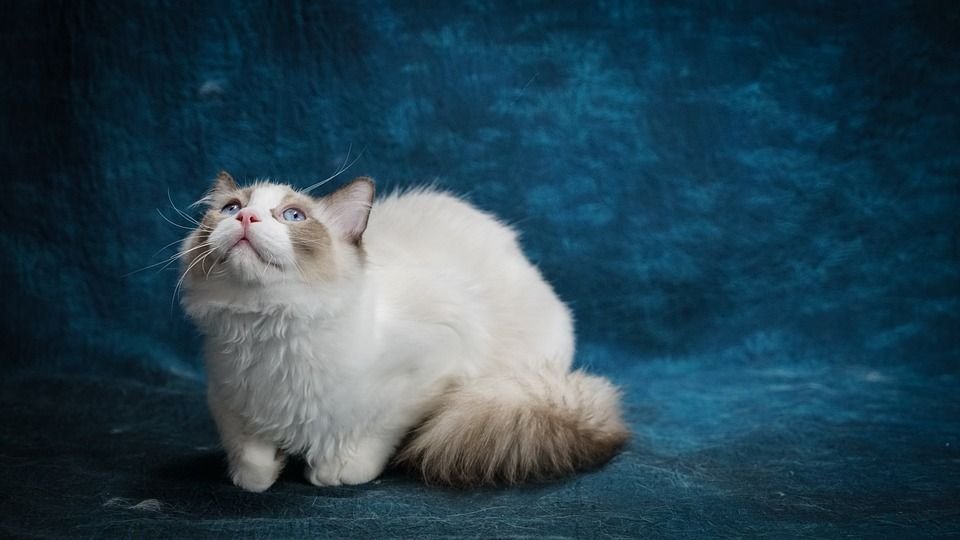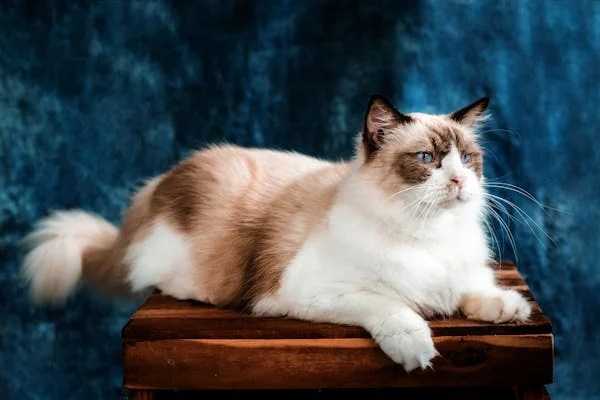Ragdoll cats adore being held, reveling in human interaction and showcasing their affectionate side through cuddles and bonding behaviors. They thrive in calm and loving environments, enjoying positive early interactions that build trust. Keep an eye out for signs like relaxed body postures, purring, and seeking out closeness to understand their love for being held. Pay attention to their comfort cues, holding them securely and respecting their boundaries. Learning how to properly hold a Ragdoll can deepen your bond and create positive experiences.
Ragdoll Cats’ Affectionate Nature
When it comes to Ragdoll cats, their affectionate nature sets them apart from many other cat breeds. These felines are known for their cuddling preferences and social interactions. Ragdolls enjoy being held and often exhibit bonding behaviors such as following their owners around the house or snuggling up close when it’s time to relax.
Their holding habits include going limp when picked up, hence the breed’s name. Ragdoll cats thrive on human interaction and are generally very outgoing and friendly. Understanding their affectionate tendencies and recognizing their need for companionship is essential in nurturing a strong bond with these loving and gentle creatures.
Understanding Ragdoll Cat Behavior
Understanding the behavior of Ragdoll cats is essential for fostering a strong bond with these affectionate and social felines. When it comes to Ragdoll cat behavior, it’s important to recognize the following:
- Playful Interactions: Ragdolls are known for their love of playtime, engaging in interactive games with their favorite humans.
- Independent Behavior: Despite their affectionate nature, Ragdolls also exhibit independence and may enjoy alone time.
- Curious Nature: Ragdolls are naturally curious cats, often exploring their surroundings with a sense of wonder.
- Relaxed Demeanor: These felines are known for their laid-back attitude, making them great companions in relaxed environments.
- Social Creatures: Ragdolls thrive on companionship and enjoy being part of a family unit, seeking out human interaction and affection.
Factors Influencing Holding Preferences
Let’s explore what influences Ragdoll cats’ preferences regarding being held. When it comes to holding preferences, Ragdolls may be influenced by their environmental factors and socialization experiences. For example, if a Ragdoll is raised in a calm and loving environment where they receive gentle handling from a young age, they may be more likely to enjoy being held.
Conversely, if a cat has had negative experiences or lacks socialization, they may be more hesitant or resistant to being held. Understanding a Ragdoll’s holding habits and past socialization experiences can provide valuable insights into their comfort levels with being held.
| Factors Influencing Holding Preferences | ||
|---|---|---|
| Environmental Factors | Socialization Experiences | Holding Preferences |
| Calm and loving environment | Positive early interactions | Enjoyment of being held |
| Noisy or stressful environment | Lack of socialization | Dislike of being held |

Signs Your Ragdoll Enjoys Being Held
Let’s explore how to tell if your Ragdoll cat enjoys being held.
Pay attention to their body language cues like relaxed posture and purring, indicating contentment.
Additionally, kneading and seeking out closeness are clear signs that your Ragdoll is comfortable and happy in your arms.
Body Language Cues
When holding a Ragdoll cat, pay attention to their body language cues to determine if they’re enjoying the interaction. Ragdolls are known for their expressive cat behavior and non-verbal cues. Here are some signs that your Ragdoll is enjoying being held:
- Relaxed body posture with limbs hanging loosely
- Slow blinking or half-closed eyes, indicating contentment
- Purring softly while being held
- Gentle kneading with their paws on you
- Ears positioned forward or slightly to the side
Understanding these non-verbal cues can help you assess your Ragdoll’s comfort level and ensure a positive holding experience for both you and your feline friend.
Purring and Kneading
Purring and gentle kneading are common behaviors displayed by Ragdoll cats when they enjoy being held. When we hold our Ragdoll cat and hear that soothing purr, it’s a clear sign of contentment and pleasure. This vocalization is a way for them to communicate their happiness and relaxation.
Additionally, many Ragdolls exhibit kneading behaviors when being held, where they rhythmically push their paws in and out against you. This action is often associated with feelings of comfort and security, as it harkens back to kittenhood when they kneaded their mother’s belly for milk. These actions, along with grooming and snuggling, are strong indicators that your Ragdoll cat enjoys being held.
| Purring | Grooming |
|---|---|
| Kneading | Snuggling |
Seeking Out Closeness
Our Ragdoll cats often demonstrate their enjoyment of being held by actively seeking out closeness with us through cuddling and nuzzling. This behavior showcases their comfort-seeking nature and strengthens the attachment bonds between us.
- Rubbing against us affectionately
- Purring loudly while being held
- Resting their head on our shoulder
- Kneading our laps with their paws
- Following us around the house for more snuggles

How to Hold a Ragdoll Cat
To properly hold a Ragdoll cat, gently scoop them up under their chest and hindquarters, supporting their body securely. When it comes to holding etiquette and proper techniques, it’s important to make sure that your cat feels safe and comfortable in your arms. Make sure to provide support for their entire body to prevent any unnecessary stress or discomfort.
Regarding holding duration and frequency, Ragdolls generally enjoy being held but it’s vital to gauge their comfort level. Start with short holding sessions and gradually increase the duration as your cat becomes more accustomed to it. Pay attention to their body language and cues to determine how often and for how long they enjoy being held.
Building Trust With Your Ragdoll
Let’s focus on establishing trust with your Ragdoll cat by creating a safe and nurturing environment for them to feel comfortable and secure.
- Trust-building activities:
Engage in interactive play sessions to build a bond based on positive experiences.
- Positive reinforcement techniques:
Reward good behavior with treats or affection to reinforce trust and positive associations.
- Bonding exercises:
Spend quality time together, such as grooming or relaxing side by side, to strengthen your connection.
- Communication strategies:
Learn to understand your cat’s body language and vocal cues to respond appropriately and build mutual understanding.
- Consistency is key:
Stick to a routine to provide your Ragdoll with a sense of security and predictability in their environment.
Handling Ragdoll Cats’ Sensitivity
Understanding the sensitivity of Ragdoll cats is vital when handling them to guarantee their comfort and well-being. When holding a Ragdoll cat, it’s important to be aware of their holding sensitivity and use gentle bonding techniques to build trust.
Pay attention to their comfort cues, such as purring or relaxed body language, to make sure they feel secure. If a Ragdoll cat shows signs of distress, like vocalization or trying to escape, it’s essential to respect their boundaries and not force the interaction.
Encouraging Positive Holding Experiences
Let’s talk about how to make holding your Ragdoll cat a positive experience for both of you.
Using proper holding techniques, such as supporting their body and not restraining them too tightly, can help your cat feel secure.
Building trust slowly and paying attention to your cat’s body language is crucial to guarantee they’re comfortable with being held.
Proper Holding Techniques
Practicing gentle and supportive holding techniques can help establish positive holding experiences for Ragdoll cats. When holding your Ragdoll, consider the following:
- Holding positions: Experiment with different holding positions to find what your cat prefers.
- Bonding experiences: Use holding as a bonding opportunity by speaking softly and offering treats.
- Comfort cues: Pay attention to your cat’s body language for cues on their comfort level.
- Trust building: Slowly build trust by starting with short holding sessions and gradually increasing the duration.
- Gentle touch: Use a gentle touch and support your cat’s body to make them feel secure and comfortable in your arms.
Building Trust Slowly
To promote positive holding experiences with Ragdoll cats, it’s crucial to gradually build trust by starting with short holding sessions and slowly increasing the duration.
Slow progress is key when it comes to gaining a Ragdoll cat’s trust. By beginning with brief holding periods and gradually extending the time, you allow the cat to become more comfortable with the experience.
It’s important to be patient and not rush the process. Remember, patience pays off when it comes to developing a strong bond with your Ragdoll cat.
Building trust slowly will help create a positive association with being held, leading to more enjoyable interactions for both you and your feline friend.
Reading Cat’s Comfort
As we hold our Ragdoll cats, it’s essential to pay close attention to their body language and vocal cues to gauge their comfort level.
- Look for comfort cues such as relaxed body posture and purring.
- Respect their holding preferences, some may enjoy being cradled while others prefer sitting on laps.
- Monitor their tail movement; a gently swaying tail can indicate contentment.
- Be mindful of their ear position; ears forward usually signal a happy cat.
- Listen for vocalizations like soft meows or chirps, which can indicate they’re enjoying the hold.
Respecting Your Ragdoll’s Boundaries
We must always be mindful of our Ragdoll cat’s signals and cues to make sure we respect their boundaries during interactions. Setting boundaries is essential in establishing trust with our feline companions.
Pay attention to their body language, such as flattened ears, twitching tails, or attempts to move away, as these are indications that they may not be comfortable with the current situation.
Avoid forcing physical contact or prolonged interaction if your Ragdoll seems uneasy. Instead, give them space and time to approach you on their terms.
Conclusion
To sum up, ragdoll cats adore being held! They crave the warmth and security of human touch and will melt in your arms with pure bliss.
By understanding their behavior, respecting their boundaries, and building trust, you can create a strong bond with your ragdoll that includes plenty of cuddles and snuggles.
So go ahead, pick up your ragdoll cat, and enjoy the love and affection they’ve to offer!

Hey guys, My name is Simon Smith. I’m from Canada and live near Victoria
I live with my sweet family and have 20+ Ragdolls of different types. I love them as my children. My profession is as a hotel manager.
I love to keep Ragdolls and grow their breeder case. I have 7 years of experience.
I’m an expert in cat care. So, I’m here to provide you with new information about my cats daily. This is my blog website, so I request that you kindly visit our site daily.
If you’re a Ragdolls lover and you have any questions or confusion about cats, text me on the Contact Us page or Gmail.
Thank u
